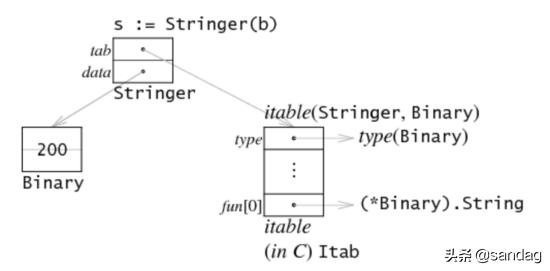Go的interface是由两种类型来实现的: iface 和 eface
iface指的是接口中申明有方法(至少1个),eface表示接口中没有申明方法
后面会讲到这两个到底是什么,所以这里需要先不用关心。
深入理解
下面是一个简单的Demo,Binary实现了fmt.Stringer接口,我们调用 ToString() 方法,会调用接口的 String() 方法。
// 类型type Binary uint64// 实现String方法,实现fmt.Stringer接口func (i Binary) String() string {return strconv.FormatUint(uint64(i), 10)}func main() {b := Binary(200) // 01 // var b Binary = Binary(200)ToString(b)// 02}func ToString(value interface{}) string { // 断言,转化成fmt.Stringer接口类型newValue, ok := value.(fmt.Stringer) //3if ok {return newValue.String()// 4}panic("The value is not implement fmt.Stringer func")}大致的执行流程图下所示:
//01 执行的是,在内存中开辟一块内存,存放200这个值

// 02 调用ToString方法,首先方法传递过程中需要隐式将b转换成interface{}类型,实际上做的就是以下:

首先大家可能会关心,我就没见过这个结构,你是不是骗人的,其实有这个结构体,是在 runtime/runtime2.go 中
type eface struct {_type *_type // 类型data unsafe.Pointer //值}那么如何转换的呢?
type 指得是 Binary的类型,包含了Binary类型的所有信息(后面会介绍到)
data 指向的真实数据,由于我们传递的不是指针,所以这种情况下其实是做了一次内存拷贝( 所以也就是尽可能的别使用interface{} ),data其实存的是拷贝的数据,如果换做是指针,其实也是拷贝了一份指针地址(这也就是reflect.Elem方法的作用)
以下这几段代码全部来自于 runtime/iface.go
// 关于 unsafe.Pointer,unsafe包学习的时候介绍过func convT2E(t *_type, elem unsafe.Pointer) (e eface) {if raceenabled {raceReadObjectPC(t, elem, getcallerpc(), funcPC(convT2E))}if msanenabled {msanread(elem, t.size)} // 首先会分配一块内存,内存大小为类型t的大小,下面这段话是mallocgc的介绍 // Allocate an object of size bytes. // Small objects are allocated from the per-P cache's free lists. // Large objects (> 32 kB) are allocated straight from the heap.x := mallocgc(t.size, t, true)// TODO: We allocate a zeroed object only to overwrite it with actual data.// Figure out how to avoid zeroing. Also below in convT2Eslice, convT2I, convT2Islice. // 将elem拷贝到x typedmemmove(t, x, elem) // eface 的类型为t,值为xe._type = te.data = xreturn}//3 其次就是到了断言的部分,那么断言到底执行了什么呢?
// inter 指的是fmt.Stringer接口类型信息// e 就是我们上面的的interface{} 的真实类型efacefunc assertE2I2(inter *interfacetype, e eface) (r iface, b bool) {t := e._typeif t == nil {return} // 获取tab,其实大家有可能不太理解tab := getitab(inter, t, true)if tab == nil {return}r.tab = tabr.data = e.datab = truereturn}那么这里就需要理解什么是 iface
type iface struct {tab *itab//tabledata unsafe.Pointer //值}tab 又是什么?
tab的意思是table的意思,关于table的概念,大家可以去找找资料 具有方法的语言通常属于以下两种阵营之一:为所有方法调用静态地准备表(如在C ++和Java中),或在每次调用时进行方法查找(如在Smalltalk及其许多模仿程序中,包括JavaScript和Python)以及添加奇特的缓存以提高调用效率。Go位于两者的中间:它具有方法表,但在运行时对其进行计算。type itab struct {inter *interfacetype// 接口类型,这里就是Stringer_type *_type// 值类型,这里就是Binaryhash uint32 // copy of _type.hash. Used for type switches._ [4]bytefun [1]uintptr // variable sized. fun[0]==0 means _type does not implement inter.}其实上面这段代码的流程如下:
data就是 eface.data
tab 其实就是 : inter 指的是接口类型(也就是fmt.Stringer接口), type 是Binary类型, fun[0] 是(Binary)String方法 ,其他几个先不用care

//4 newValue.String() 到底做了啥,其实根据上面我们很容易知道,无法就是 newValue.tab.fun[0].(newValue.data) ,所以就是这么简单。
总结
1、go的 interface{} 转换过程中至少做一次内存拷贝,所以传递指针是最好的选择。
type User struct {Name stringAge int}func main() { var empty interface{} = User{} //这里会拷贝一次,将user转换成interface{},所以函数传递过程中也别直接使用结构体传递}正确写法
func main() {var empty interface{} = &User{}}2、有人会问到字符串传递是否内存拷贝,回答否,因为字符串底层是一个 byte[] 数组,他的结构组成是
type StringHeader struct {Data uintptr //数据,是一个二进制数组Len int// 长度}所以64位计算机,字符串的长度是128位,占用16个字节
3、减少使用 interface{} ,因为会有不必要的开销,其次Golang本身是一个强类型语言,静态语言,申明式是最好的方式。
4、 interface{} 是反射的核心,后期我会讲解反射




















 459
459











 被折叠的 条评论
为什么被折叠?
被折叠的 条评论
为什么被折叠?








